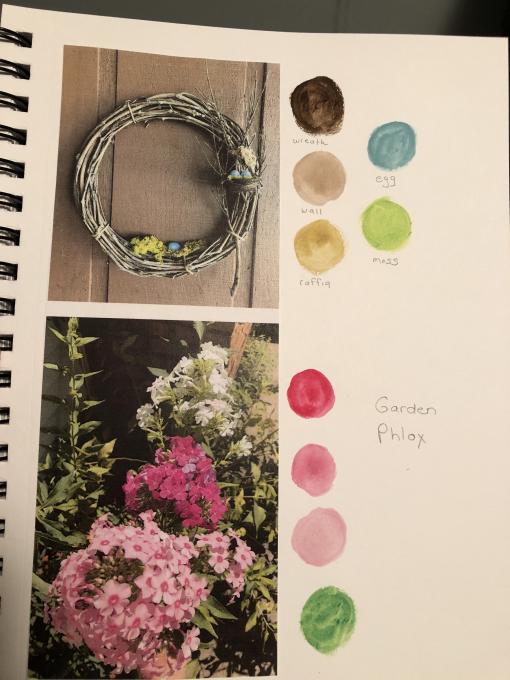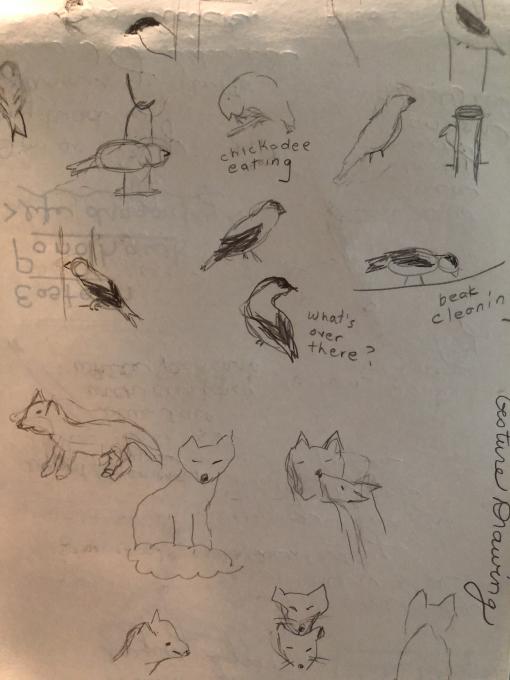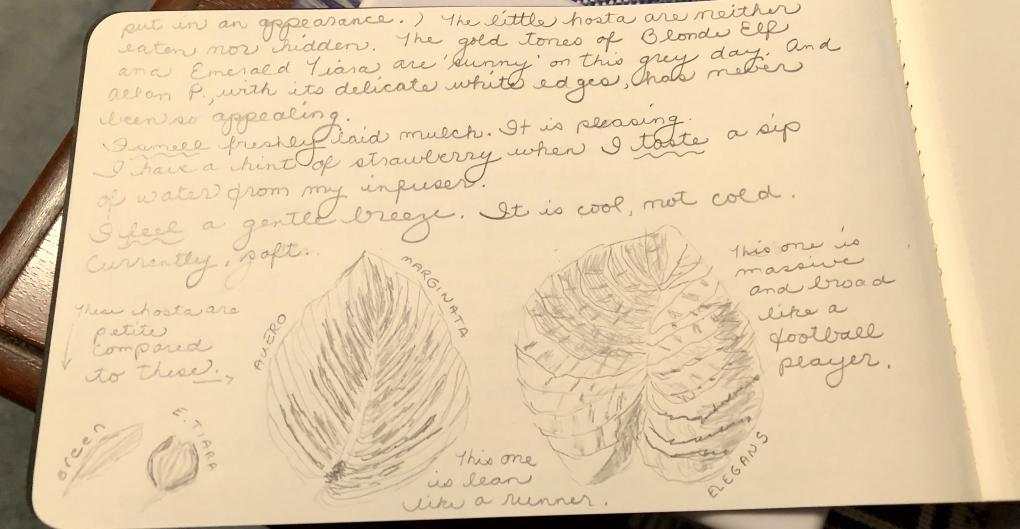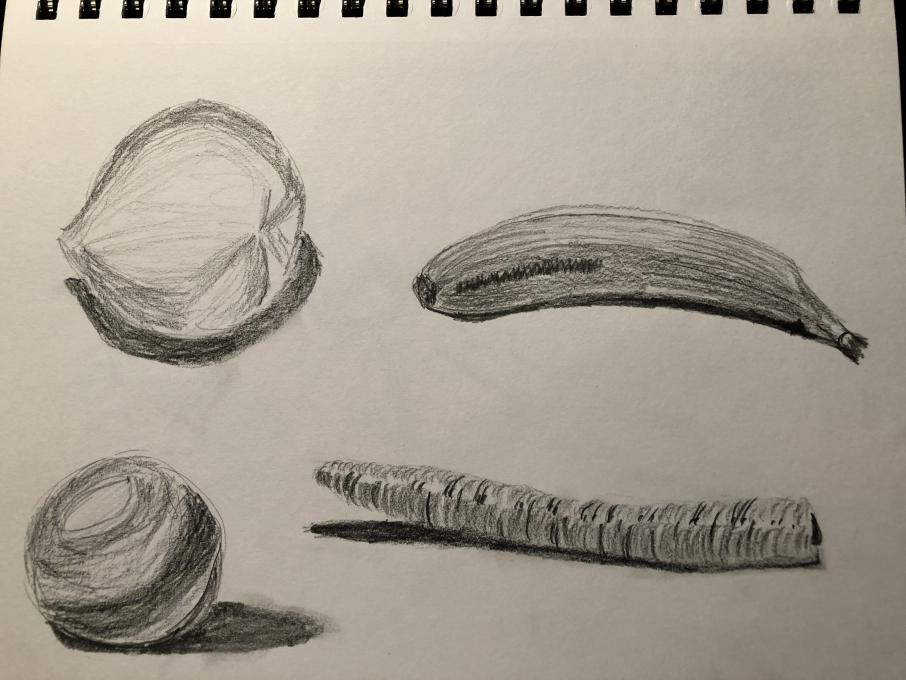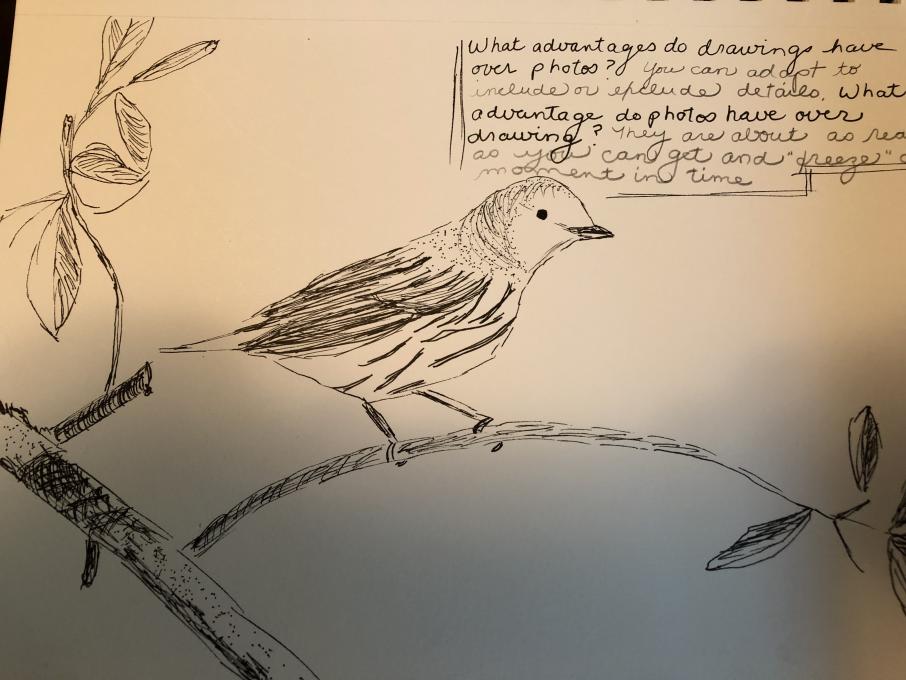Jill
Forum Replies Created
Viewing 20 posts - 1 through 20 (of 20 total)
-
JillParticipantThanks to Liz and Bird Academy for this simply splendid course. I learned so much and enjoyed it tremendously. I am sad to be at the last lesson. I had many great journaling experiences. I picked three: the spoonbill, one of my first entries in color, and a recent sit spot.
 After "Refine a Gesture Sketch," I sketched this spoonbill from a reference photo. We saw it in January on a pre-Covid trip to the Texas coast. I was happy how he turned out.
After "Refine a Gesture Sketch," I sketched this spoonbill from a reference photo. We saw it in January on a pre-Covid trip to the Texas coast. I was happy how he turned out.
 This was one of my first color attempts. I forgot that I added some lines of poetry to the sketch but I'm glad that I did.
This was one of my first color attempts. I forgot that I added some lines of poetry to the sketch but I'm glad that I did.
 This was from a recent Sit Spot on a dock on an island in Lake Michigan. I so enjoyed drawing these birds from life. I was especially delighted to have plenty of time with the snow bunting. because I so rarely see them. The gull did have feet in case you are worried. He flew away before I could draw them. in reply to: Tips to Keep You Going #745919
This was from a recent Sit Spot on a dock on an island in Lake Michigan. I so enjoyed drawing these birds from life. I was especially delighted to have plenty of time with the snow bunting. because I so rarely see them. The gull did have feet in case you are worried. He flew away before I could draw them. in reply to: Tips to Keep You Going #745919 -
JillParticipant

 The two drawings, of course, differ. The first one in pen was done fairly quickly. It’s kind of cute but rather cartoonish. The second color one took longer. The new techniques which I worked on were keeping in mind negative space and adding color. I must keep working on proportion and learning how to use watercolor. Besides proportions, I also struggled with his wings. I think they were challenging. I most pleased with his head. I got some shading on it, and I like his eye. in reply to: See How Far You’ve Come #745442
The two drawings, of course, differ. The first one in pen was done fairly quickly. It’s kind of cute but rather cartoonish. The second color one took longer. The new techniques which I worked on were keeping in mind negative space and adding color. I must keep working on proportion and learning how to use watercolor. Besides proportions, I also struggled with his wings. I think they were challenging. I most pleased with his head. I got some shading on it, and I like his eye. in reply to: See How Far You’ve Come #745442 -
JillParticipantI was able to sit for 30 minutes or so with a snow bunting today. Then I used the prompt to write this. "Conversing with a Snow Bunting" Snow bunting, here we meet on the dock. Human, here we meet on the dock. Bunting, where did you spend your summer, on what faraway tundra? What is tundra like? I don't know. Human, where did you spend your summer, in what city? What is a city like? I don't know. Bunting, will you winter here or migrate further south? Human, will you winter here or migrate farther south? Bunting, what's that you're finding in the gravel and the grass? Human, what's that you're finding in that flat thing that flaps in the wind? What are you doing with that stick? Bunting, when did your feathers change to wintertime white, caramel, and black? Human, where are your feathers? Bunting, I wish I could talk to you. I'm sorry that I don't speak 'sparrow.' Human, I wish I could talk to you. Sorry, I don't speak human.in reply to: The Power of Reflection #741929
-
JillParticipantBeginning to work with color provides all new challenges plus, also, new fun.

 in reply to: Filling Your Sketches with Color #738349
in reply to: Filling Your Sketches with Color #738349 -
JillParticipantI've gotten interested in seeing and drawing negative space now that I better understand what it means. I also used the squint test to assess lights and darks. Getting proportions right is still difficult. Sighting with my pencil remains tricky. But I am trying to look more for how parts of the subject relate to each other. Above all, I think I need patience! Do a little. Set it aside. Then do a little more. I may not like what I am working on. But if I set it aside and come back, it may not seem as bad and I can see what I need to work on.
 in reply to: Giving Your Drawings Depth #730174
in reply to: Giving Your Drawings Depth #730174 -
JillParticipantYes, it was difficult. Yes, it was fun. I stopped and started working on it because it required concentration. I didn’t view it as a bird, except maybe the eye. I thought a lot about negative space, proportion, and sketchy lines. I’m happy with how he turned out. So ultimately it was fun.
 in reply to: Drawing What You See – Upside Down Drawing #727363
in reply to: Drawing What You See – Upside Down Drawing #727363 -
JillParticipant
 The sky, water, and trees were first wet on wet with some wet brush on top once the paper had dried. The fence was from a dry brush. The grass was wet on dry. in reply to: Getting Comfortable with Watercolor #726104
The sky, water, and trees were first wet on wet with some wet brush on top once the paper had dried. The fence was from a dry brush. The grass was wet on dry. in reply to: Getting Comfortable with Watercolor #726104 -
JillParticipantI had previously tried only wet on dry. I thought wet on wet was the most interesting. I need much more experience with each to learn what works and what doesn’t and how I could use them in my journals.in reply to: Getting Comfortable with Watercolor #725487
-
JillParticipant1. Unless you count messing around with watercolors as a child, this was a new experience for me. I didn't know what to expect so it wasn't easy or difficult. 2. I was very confused about what "Then take your watercolors and nature journal outside and try them on a subject of interest" meant! From the posts, I think others were confused also. Finally, I decided to take a couple photos outside and create color palettes for them. This seemed a reasonable interpretation and a helpful experience in blending colors. I don't have any idea how to start an actual painting yet. My subjects were a wreath and phlox in the garden. I suppose I found a decent palette for both. I don't know if the shades were exact matches, but I am not sure that it matters as along as they are pleasing. 3. The phlox that I originally planted were all the same color, but they are not any more. How and why did they change into different colors?
 in reply to: Capturing Nature’s Color Palettes #725163
in reply to: Capturing Nature’s Color Palettes #725163 -
JillParticipantI took a prior class that covered drawing proportions, and I hated that one too. I find it very difficult and don't really know what I am doing. But, of course, proportion is important, or drawings look lopsided and odd. I guess I will have to keep at it. I also was introduced to negative space not too long ago. It didn't make sense then, but this time, it made much more sense and is quite interesting. I tried a drawing in the field as Liz did in this lesson. Using the measuring technique, or at least trying to, I think that I got the proportion of the leaves more accurate. They became larger and larger the closer that they got to the ground. My first attempts were too small. Thank goodness for erasers. I was interested to observe the negative space between the leaves. But I didn't have much time to develop the drawing.
 in reply to: Getting the Proportions Right #724686
in reply to: Getting the Proportions Right #724686 -
JillParticipantOf course gesture drawing causes me to pay more attention! I think that I chose an unfortunate subject to try in the field: dragonflies. I thought birds could move quickly, but they are slow-pokes compared to dragonflies. Dragonflies were fun to watch, but they also made me dizzy since they moved so fast. The birds at my feeder were a little better to observe.
 in reply to: Capturing Behavior – Gesture Drawing #723722
in reply to: Capturing Behavior – Gesture Drawing #723722 -
JillParticipantNot sure that I get the point of this. My drawings were not uninteresting, but were rather odd. Yes, they forced me to be focused on the subject. But again, why do this? If there were positives in what I drew, they escaped me. Weird.in reply to: Focusing on Your Subject – Blind Contour Drawing #721072
-
JillParticipantI did a comparison study on two volunteer trees in my backyard. What I learned is that despite thinking that I pay attention to nature, I don't. I missed so many details. This exercise caused me to look so much more closely. I didn't know what one of the trees was. My tree key was of no help, which was extremely frustrating. My son-in-law identified it with his tree key as a White Mulberry. It turns out the White Mulberry was not in my key, only the Red Mulberry and only with mature leaves. Apparently the leaves change shape as the tree ages. Why? The other tree we confirmed was a White Poplar. I had never even noticed the unusual diamond pattern of its bark! The trees came to my yard via their underground system of root suckers from a tree in a neighbor's yard. This study led me down a path to find more information online, which lead me back to look at the trees, which led me back to more study and drawing, and on and on.
 in reply to: The Power of Comparison #719601
in reply to: The Power of Comparison #719601 -
JillParticipantWhere do you live?in reply to: Opening Your Senses #717530
-
JillParticipantIn what country do you live?in reply to: Opening Your Senses #717529
-
JillParticipantToday was rainy, so I sat on my front porch. At first, it was hard to sit and be still. I look around and listen often. But this was different. I paid far more attention and noticed more. I heard a blue jay call. I don't think they are common in my neighborhood, or are they? Are they around, but I don't tune into them? Squirrels spiraled down the tree trunk. I've seen them do that often, but today, I asked "Why do they spiral?" When attending to measurements, I noticed the huge difference in size and shape of the hosta leaves right next to the door.
 in reply to: Opening Your Senses #717526
in reply to: Opening Your Senses #717526 -
JillParticipantI still want to work on everything! But I took my first-ever drawing class in the fall and was introduced to most of these concepts. So I was not completely uncomfortable or unfamiliar with them. My goal is 'not pathetic.'

 in reply to: Illustrating the 3D World #717439
in reply to: Illustrating the 3D World #717439 -
JillParticipant1. Yellow warblers don't pose, so it was good to have one hold still in the photo. It was all pretty challenging. I decided to try the pens that I got for the course. I think pen is less forgiving than pencil because you can't erase or shade. I tried to draw the whole scene and getting the texture of the bark was quite difficult/impossible. Plus, my bird looks 'flat,' not round. 2. I would not have noticed the shading around the head and back of the bird without drawing. Nor would I have noticed the 'stripey' look to the wings. So a nature journal would make you stop and look more closely.
 in reply to: Jump Right in! #713302
in reply to: Jump Right in! #713302 -
JillParticipantYes, I think you did just fine!in reply to: Jump Right in! #713292
-
JillParticipantI'm an outdoor lover and active birder. I spend as much time outside as I can. Since I live in the upper Midwest, it is highly seasonal how often I can be out. I actually wrote a nature journal in the '80s that my sister illustrated. Since then, I've seen a couple exhibitions with field sketches and botanical illustrations that I thought we stunning and wonderful. So when I saw this class, I immediately wanted to take it. Yet I've been procrastinating and feeling intimidated. I'm not artist, and I'm the type whose stuff should always be 'good.' So it will be a stretch and challenge for me to try this. But it will also be healthy and give me another reason to explore outside.in reply to: Style Your Journal Your Way #713276
Viewing 20 posts - 1 through 20 (of 20 total)
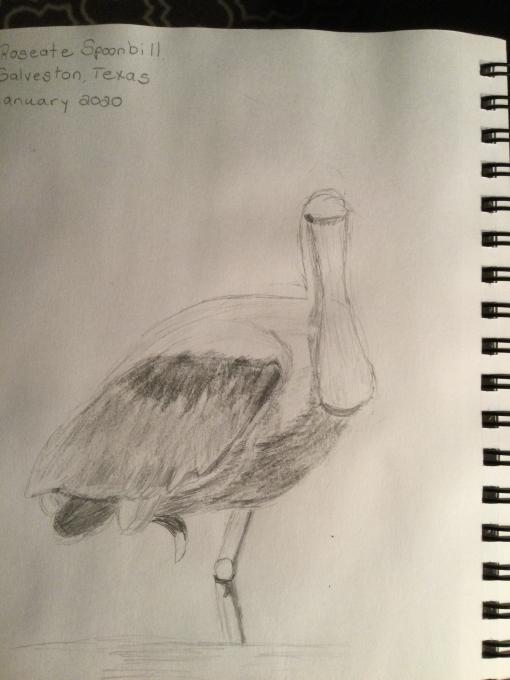 After "Refine a Gesture Sketch," I sketched this spoonbill from a reference photo. We saw it in January on a pre-Covid trip to the Texas coast. I was happy how he turned out.
After "Refine a Gesture Sketch," I sketched this spoonbill from a reference photo. We saw it in January on a pre-Covid trip to the Texas coast. I was happy how he turned out.
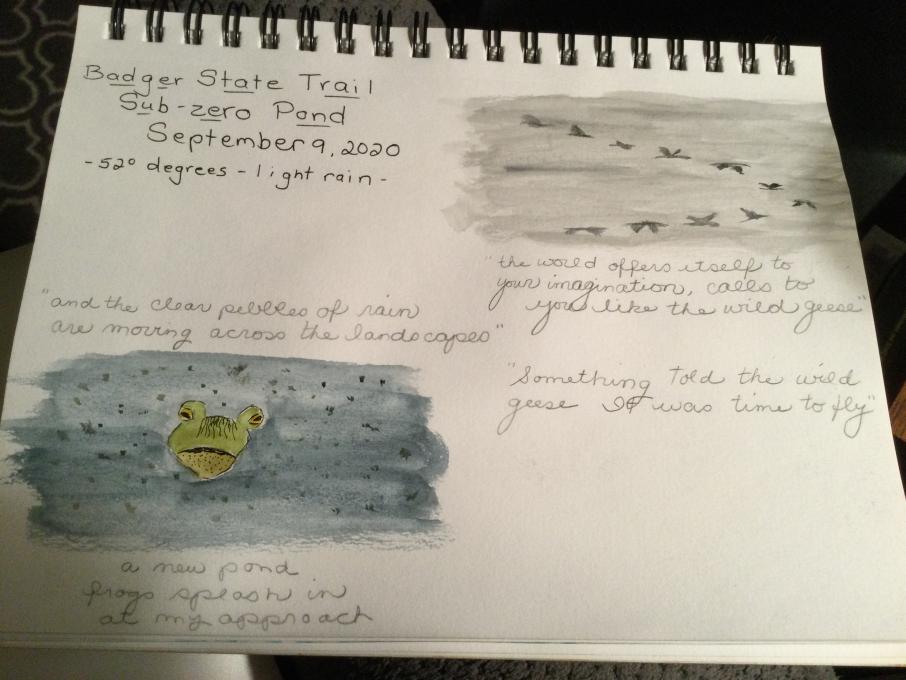 This was one of my first color attempts. I forgot that I added some lines of poetry to the sketch but I'm glad that I did.
This was one of my first color attempts. I forgot that I added some lines of poetry to the sketch but I'm glad that I did.
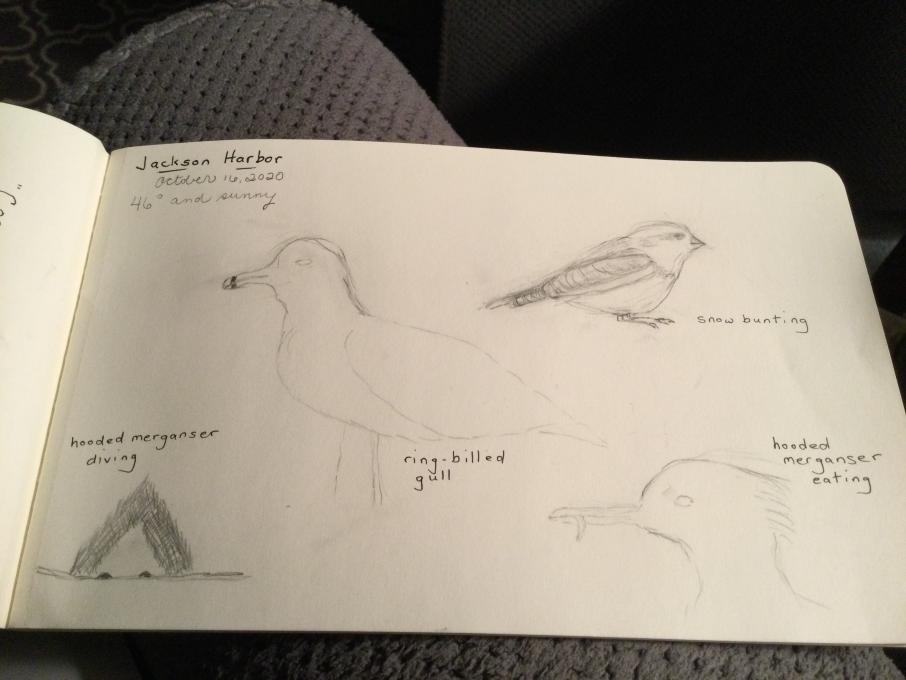 This was from a recent Sit Spot on a dock on an island in Lake Michigan. I so enjoyed drawing these birds from life. I was especially delighted to have plenty of time with the snow bunting. because I so rarely see them. The gull did have feet in case you are worried. He flew away before I could draw them.
This was from a recent Sit Spot on a dock on an island in Lake Michigan. I so enjoyed drawing these birds from life. I was especially delighted to have plenty of time with the snow bunting. because I so rarely see them. The gull did have feet in case you are worried. He flew away before I could draw them. 
 The two drawings, of course, differ. The first one in pen was done fairly quickly. It’s kind of cute but rather cartoonish. The second color one took longer. The new techniques which I worked on were keeping in mind negative space and adding color. I must keep working on proportion and learning how to use watercolor. Besides proportions, I also struggled with his wings. I think they were challenging. I most pleased with his head. I got some shading on it, and I like his eye.
The two drawings, of course, differ. The first one in pen was done fairly quickly. It’s kind of cute but rather cartoonish. The second color one took longer. The new techniques which I worked on were keeping in mind negative space and adding color. I must keep working on proportion and learning how to use watercolor. Besides proportions, I also struggled with his wings. I think they were challenging. I most pleased with his head. I got some shading on it, and I like his eye. 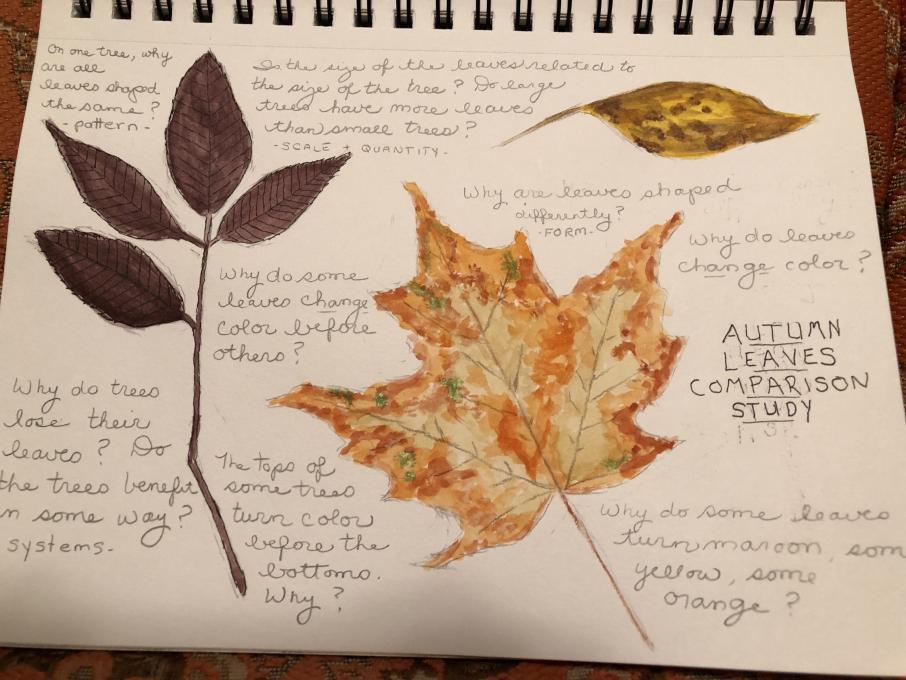
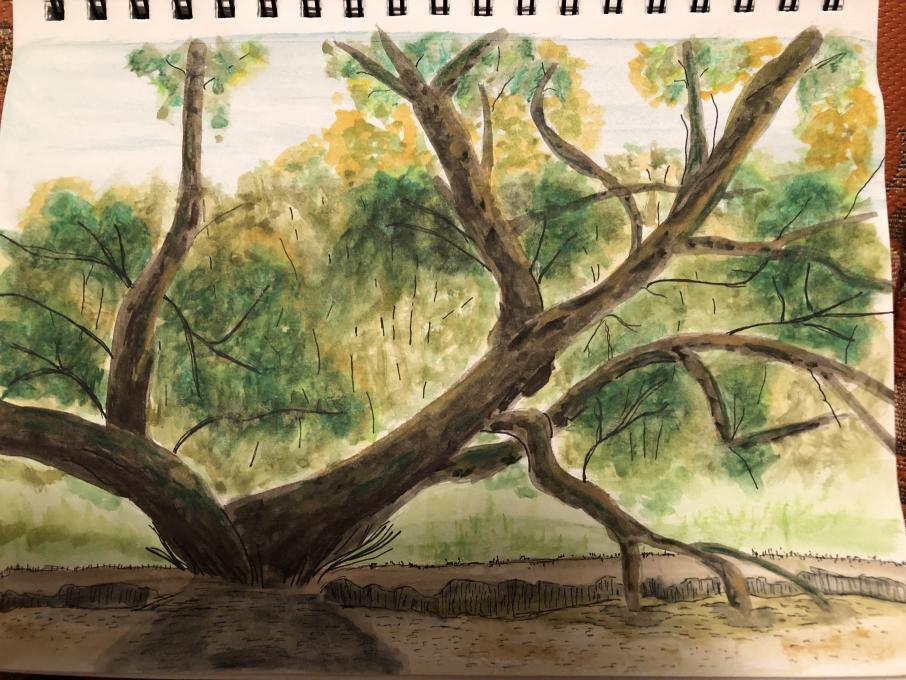


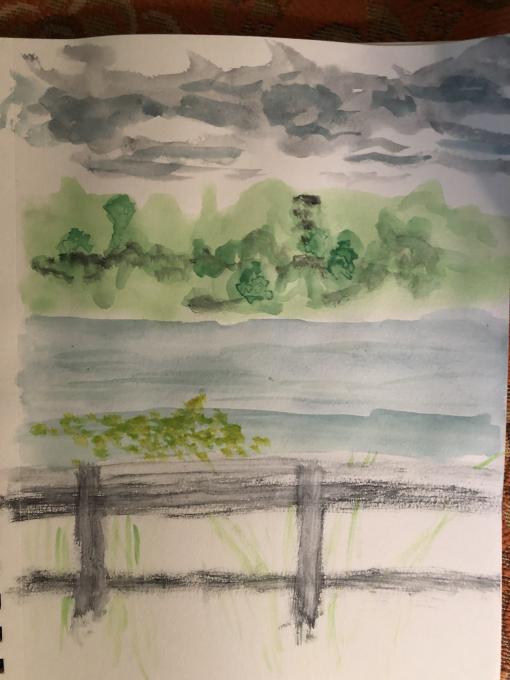 The sky, water, and trees were first wet on wet with some wet brush on top once the paper had dried. The fence was from a dry brush. The grass was wet on dry.
The sky, water, and trees were first wet on wet with some wet brush on top once the paper had dried. The fence was from a dry brush. The grass was wet on dry. 